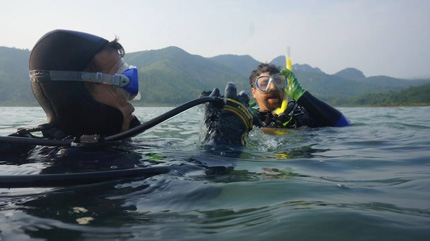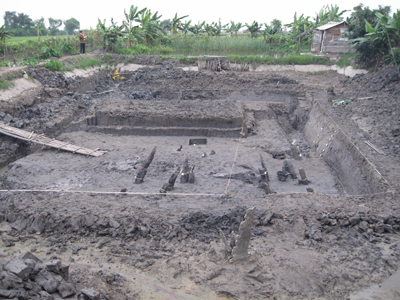
SCUBA diving at Van Don (Quan Lan island) in 2013 (photo by Ian McCann courtesy of the Bach Dang River and Van Don Research Team).
Introduction
Six fieldwork research and training seasons (2008-2013) have been conducted in Vietnam by an interdisciplinary, international team of researchers, research associates, students and trainers that includes specialists in archaeology, surveying, geophysical research, palaeo-landscape and memory studies from the USA, Australia, Canada, Japan and Vietnam. The team has been working cooperatively and collaboratively with the Institute of Archaeology (IA) at the Vietnamese Academy of Social Sciences (VASS), as well as universities, NGOs, national, provincial and district government organisations and individuals, to research, interpret and raise awareness about maritime and underwater archaeological sites and artefacts in Vietnam.
The new Underwater Archaeology Department of the Institute of Archaeology (In Vietnamese: Phòng Khảo cổ học Dưới nước) formally started operations on the 1st July, 2013, with the Decision No. 141/QĐ-KCH, dated the 25th June, 2013 which nominated Dr. Le Thi Lien as Head of the Underwater Archaeology Department.
The main functions of the Department are:
1) Surveys, rescue excavations and inventory of underwater archaeological sites in Vietnam;
2) Research on underwater archaeological sites and artifacts, and related documents to improve the knowledge on maritime history, history of cultural exchanges and trade on the sea around Vietnam;
3) International cooperation in research and training programs, and in capacity building activities for Vietnamese underwater archaeology;
4) In collaboration with the Journal “Khao co hoc” for the publication of papers on underwater archaeology.

Excavation at Dong Ma Ngua in 2010 (photo by Nguyen Thi Mai Huong courtesy of the Bach Dang River and Van Don Research Team).
Vietnam has a very long coastline (more than 3,000 km) and seafaring activity has been extensive for more than 2,000 years. Vietnam is centrally located in South East Asia, and was on the "Maritime Silk Route" that ran from China to the west via the South China Sea. At this stage little is known about how many shipwrecks or other maritime and underwater cultural heritage sites might exist in Vietnam as there has been very little maritime archaeology survey work done, but it has been suggested that there will be thousands of sites. The new Underwater Archaeology Department will investigate shipwrecks and the remains of ports as well as prehistoric and other sites underwater
This website is designed to help increase awareness at local, provincial, national and international levels about the extent and nature of Vietnam’s underwater and maritime cultural heritage. Some of this is based on on-going research projects, some are cultural heritage management activities and some are about awareness raising and capacity building (training). We hope to present material from individual researchers, research teams and government agencies about a range of maritime archaeology projects as well as maritime and underwater cultural heritage investigations that are being conducted in Vietnam today.
If you have comments or wish to contact us you can email: Mark.staniforth@monash.edu
Next
